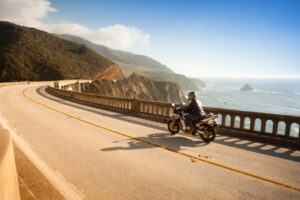
India is one of the largest two-wheeler markets in the world. With time new technologies are introduced to make our rides more safe and comfortable. Some of the top two-wheeler technologies are-
Anti-lock Braking System
An Anti-lock Braking System or ABS has become a salient feature in motorbikes. Initially, it was considered an exquisite tech and only meant for four-wheelers. However, now any two-wheeler above 125cc has ABS.
ABS is tech meant for a safer ride. It prevents the locking of wheels while hitting brakes and in turn avoids skidding. It helps to maintain grip and stability on the road. When a rider hits the brake in an urgent situation or on slippery road wheels get locked, ABS helps in reducing the pressure on the brake allowing the rider to control the motorcycle and slow down the vehicle safely.
State Transport Department has made it mandatory that new two-wheelers from 1 April 2019 above 125cc should have ABS and bikes below 125cc should have CBS (Combined Braking System). However, ABS is not for off-road bike riding.
Anti Lock Braking System can be found in TVS Apache RTR 180, Bajaj Pulsar RS200, KTM 390 Duke, Benelli TNT 600i, etc.

Slipper Clutch
A Slipper Clutch or back-torque limiter clutch is meant for the situation when a rider needs to apply brakes quickly and also save oneself from losing control and falling on the road. Now, imagine yourself riding on the bike at high speed without a slipper clutch and suddenly a boy comes in front to save that boy you apply the brake. A sudden brake causes your bike to wobble and you fall. Now again imagine yourself in the same situation but this time your motorbike has a slipper clutch you will be safe.
When a rider is at high speed and applies brake quickly the rear wheel wobbles and makes the rider fall but the slipper clutch keeps the motorbike in control in such situations. A slipper clutch increases the durability of the engine. It also prevents the rear wheel from locking up and also improves the performance of the motorbike.
Earlier slipper clutch was available only in high-end bikes but now its also available in affordable bikes such as Bajaj Dominar 400,
TVS Apache RTR 200 4V, KTM RC 390, Yamaha R15.

Ride by wire
With the introduction of Ride-by-Wire technology in two wheeler, any physical connection between the accelerator and throttle has been removed and replaced by the sensor connected by a wire. This sensor decides how much mixture of air and fuel should enter the motorcycle engine. This ride-by-wire technology has been introduced by Yamaha for the first time on YZF-R6. This technology was also first used only on high-capacity motorbikes used on race tracks. Now, this is also found in low-capacity bikes. One of the main features of ride-by-wire technology is that manufacturers can stick to precise emission norms and can also make high displacement motorcycles.
The primary advantage of ride-by-wire technology is that the engine receives the right amount of fuel and air. Different ride modes can also be integrated such as sport, tour, rain, etc. like high displacement motorbikes. Also provides cruise control. Cruise control, allows the rider to maintain a particular speed without any throttle input.
Motorbikes such as Triumph Tiger Explorer, Ducati Diavel Carbon, Kawasaki ZX10 Yamaha R6, etc.

Traction control
As motorcycles grew powerful and heavy engines were used to support them a new problem of wheel spin occurred. when the throttle of the bike is twisted powerfully the rear heel starts to spin like crazy and the front wheel remains motionless. Traction control is a tech introduced for the same problem. Traction means the friction between road and wheel and control is to control it. Friction control is not necessary on low-capacity bikes because these bikes do not produce much friction. Now bikes with high capacity have traction control in them so that no rider becomes the victim of abrupt spinning of the rear wheel. Traction control measures the speed of the wheel ABS sensor and an ECU is used.
There are two types of traction control
Reactive- Reactive traction system works when the wheel spins and tries to bring the fraction under the wheel.
Predictive- predictive traction control works before the wheel begin to spin. Making the ride safe from the very beginning.
Bikes such as Yamaha R15 V4, Kawasaki Ninja H2, Suzuki Hayabusa, Kawasaki Ninja ZX-10R, etc.
